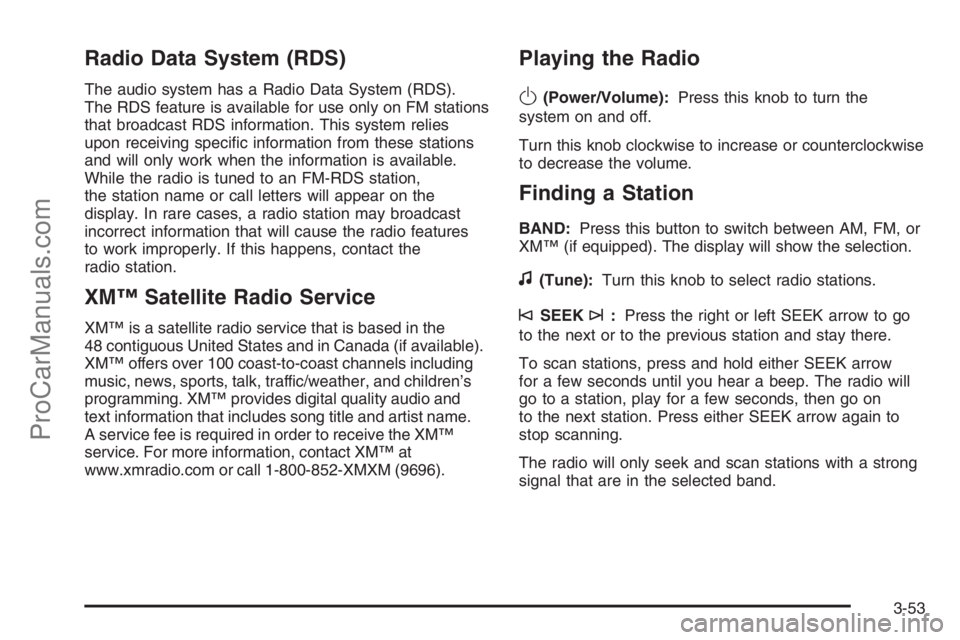2006 SATURN VUE child lock
[x] Cancel search: child lockPage 173 of 412

Radio Data System (RDS)
The audio system has a Radio Data System (RDS).
The RDS feature is available for use only on FM stations
that broadcast RDS information. This system relies
upon receiving speci�c information from these stations
and will only work when the information is available.
While the radio is tuned to an FM-RDS station,
the station name or call letters will appear on the
display. In rare cases, a radio station may broadcast
incorrect information that will cause the radio features
to work improperly. If this happens, contact the
radio station.
XM™ Satellite Radio Service
XM™ is a satellite radio service that is based in the
48 contiguous United States and in Canada (if available).
XM™ offers over 100 coast-to-coast channels including
music, news, sports, talk, traffic/weather, and children’s
programming. XM™ provides digital quality audio and
text information that includes song title and artist name.
A service fee is required in order to receive the XM™
service. For more information, contact XM™ at
www.xmradio.com or call 1-800-852-XMXM (9696).
Playing the Radio
O
(Power/Volume):Press this knob to turn the
system on and off.
Turn this knob clockwise to increase or counterclockwise
to decrease the volume.
Finding a Station
BAND:Press this button to switch between AM, FM, or
XM™ (if equipped). The display will show the selection.
f(Tune):Turn this knob to select radio stations.
©SEEK¨:Press the right or left SEEK arrow to go
to the next or to the previous station and stay there.
To scan stations, press and hold either SEEK arrow
for a few seconds until you hear a beep. The radio will
go to a station, play for a few seconds, then go on
to the next station. Press either SEEK arrow again to
stop scanning.
The radio will only seek and scan stations with a strong
signal that are in the selected band.
3-53
ProCarManuals.com
Page 215 of 412

Try to adjust your speed so you can “drive” through the
curve. Maintain a reasonable, steady speed. Wait to
accelerate until you are out of the curve, and then
accelerate gently into the straightaway.
Adding non-Saturn accessories can affect your
vehicle’s performance. SeeAccessories and
Modi�cations on page 5-3.
Steering in Emergencies
There are times when steering can be more effective
than braking. For example, you come over a hill and �nd
a truck stopped in your lane, or a car suddenly pulls
out from nowhere, or a child darts out from between
parked cars and stops right in front of you. You
can avoid these problems by braking — if you can stop
in time. But sometimes you cannot; there is not room.
That is the time for evasive action — steering around
the problem.
Your vehicle can perform very well in emergencies
like these. First apply your brakes — but, unless you
have anti-lock brakes, not enough to lock your wheels.
SeeBraking on page 4-7. It is better to remove as
much speed as you can from a possible collision.
Then steer around the problem, to the left or right
depending on the space available.An emergency like this requires close attention and a
quick decision. If you are holding the steering wheel
at the recommended 9 and 3 o’clock positions, you can
turn it a full 180 degrees very quickly without removing
either hand. But you have to act fast, steer quickly,
and just as quickly straighten the wheel once you have
avoided the object.
The fact that such emergency situations are always
possible is a good reason to practice defensive driving
at all times and wear safety belts properly.
4-13
ProCarManuals.com
Page 272 of 412

Filling the Tank
{CAUTION:
Fuel vapor burns violently and a fuel �re can
cause bad injuries. To help avoid injuries to you
and others, read and follow all the instructions
on the pump island. Turn off your engine when
you are refueling. Do not smoke if you are near
fuel or refueling your vehicle. Keep sparks,
�ames, and smoking materials away from fuel.
Do not leave the fuel pump unattended when
refueling your vehicle — this is against the law
in some places. Keep children away from the
fuel pump; never let children pump fuel.The tethered fuel cap is located behind a hinged fuel
door on the passenger’s side of the vehicle.
To remove the fuel cap, turn it slowly counterclockwise.
The fuel cap has a spring in it; if the cap is released
too soon, it will spring back to the right.
5-8
ProCarManuals.com
Page 405 of 412

J
Jump Starting.................................................5-42
K
Keyless Entry System....................................... 2-3
Keys............................................................... 2-2
L
Labeling, Tire Sidewall.....................................5-57
Lamps
Battery Run-Down Protection.........................3-17
Dome ........................................................3-16
Fog ...........................................................3-15
Footwell.....................................................3-17
Interior.......................................................3-16
Map ..........................................................3-17
LATCH System
Child Restraints...........................................1-44
Liftgate..........................................................2-11
Light
Airbag Readiness........................................3-28
Anti-Lock Brake System Warning...................3-33Light (cont.)
Battery Warning..........................................3-31
Brake System Warning.................................3-32
Change Engine Oil......................................3-41
Daytime Running Lamps Indicator..................3-42
Engine Coolant Temperature Warning.............3-35
Gate Ajar...................................................3-42
Highbeam On.............................................3-42
Low Coolant Warning...................................3-36
Low Fuel Warning.......................................3-44
Low Traction...............................................3-35
Malfunction Indicator....................................3-37
Oil Pressure...............................................3-40
Passenger Airbag Status Indicator..................3-29
Passenger Safety Belt Reminder....................3-27
Reduced Engine Power................................3-41
Safety Belt Reminder...................................3-27
Security.....................................................3-41
Service Vehicle Soon...................................3-42
TCS Warning Light......................................3-34
Traction Control System (TCS) Warning..........3-34
Up-Shift.....................................................3-32
Lighting
Entry.........................................................3-16
Loading Your Vehicle.......................................4-44
Lockout Protection..........................................2-11
7
ProCarManuals.com
Page 407 of 412

O
Odometer......................................................3-26
Odometer, Trip...............................................3-26
Off-Road Driving.............................................4-17
Off-Road Recovery..........................................4-14
Oil
Change Engine Oil Light...............................3-41
Engine.......................................................5-15
Pressure Light.............................................3-40
Oil, Engine Oil Life System..............................5-19
Older Children, Restraints................................1-32
Online Owner Center........................................ 7-4
OnStar
®System, see OnStar®Manual...............2-32
Outlet Adjustment............................................3-22
Outlet(s), Accessory Power...............................3-17
Outside
Convex Mirror.............................................2-31
Power Mirrors.............................................2-31
Owner Checks and Services.............................6-10
Owners, Canadian............................................... ii
P
Paint, Damage...............................................5-91
Park (P)
Shifting Into................................................2-25
Shifting Out of............................................2-26
Parking
Brake........................................................2-24
Over Things That Burn.................................2-27
Parking Your Vehicle.......................................2-26
Passenger Airbag Status Indicator.....................3-29
Passenger Compartment Air Filter.....................3-22
Passenger Sensing System..............................1-67
Passing.........................................................4-14
Passlock
®......................................................2-14
Power ............................................................. 1-3
Accessory Outlet(s)......................................3-17
Door Locks.................................................. 2-8
Electrical System.........................................5-94
Reduced Engine Light..................................3-41
Windows....................................................2-13
Pretensioners, Safety Belt................................1-31
Programmable Automatic Door Locks.................. 2-9
9
ProCarManuals.com